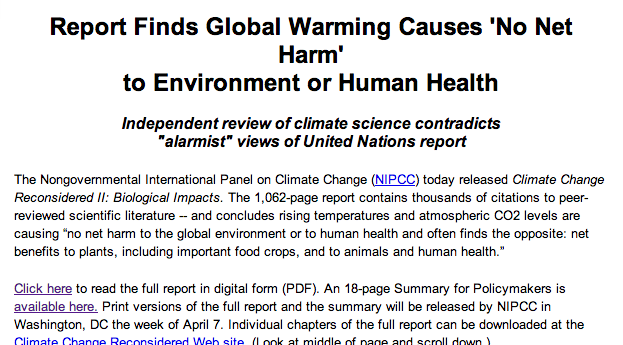I opened my email this morning after Today in Amarillo and had a message waiting for me.
Whew. That was a close one. Glad we all dodged that bullet.
You, too can read about this great breakthrough here. Or, if that is too long, the summary here.
Some digging is in order
I have bad news: the above claims are unlikely to be correct. Sorry.
Oh, and the people authoring those claims might be biased. The research performed, and the publisher, might need to be researched for flaws, too.
In fact, it seems as those the claims made by the headline have more holes than swiss cheese. The climate is changing due to CO2. It is our fault. It is not good. And, based on roughly 11,000 articles on climate science, the previous three sentences are true.
So perhaps, we should pause for a moment and reflect on actual science before we believe a headline. But that isn’t what Jim Lakely wants you to think. He is the one who sent me the email. His bio is here: http://heartland.org/jim-lakely. And yes, he works for the Heartland Institute.
I don’t blame Mr. Lakely for bad science, though, he is just doing his job.
It’s the Heartland Institute that should probably be fact-checked here. After all, it is known for some great scientific pioneering. Just google it.
But I’m not trying to tear down a non-profit organization unfairly. I’m sure they do a lot of good things. This is about taking things at face value. Doing so without investigating the details further is a disservice to you and to the people with whom you interact.
And the people who you may “share” this story with on social media.
The “Lead Authors / Editors” are a group of people that have – individually – done more than challenged climate change.
One has challenged the risks of smoking tobacco.
One is not formally educated in climate science.
Another argued against UV-B radiation as a cause of skin cancer.
Respectfully, it seems like this is a group of science contrarians. It’s not bad. It’s just an observation.
Fact-Checking
I’m not here to point fingers. I’m here to expose the “findings” presented in the summary for what they are. Or are not. I will do so by posting information and links to other peer-reviewed work.
Atmospheric carbon dioxide is not a pollutant.
I can’t disagree with this. If by “atmospheric carbon dioxide” the authors mean “naturally occurring” carbon dioxide. If they mean carbon dioxide emissions from factories and vehicles, then it becomes a pollutant.
The dictionary definition of “pollutant” reads as follows: “Any substance, as certain chemicals or waste products, that renders the air, soil, water, or other natural resource harmful or unsuitable for a specific purpose.”
I think that introducing more CO2 into the atmosphere could render it harmful to certain ecosystems. For example, coral reefs. Or rain forests. Or every ecosystem on the planet.
The ongoing rise in the air’s CO2 content is causing a great greening of the Earth.
Again, I agree. In certain places an increase in CO2 is causing a “greening” effect. Like the deserts. But is that necessarily a good thing? Maybe not. The consequences of “greening” an area include water scarcity, carbon cycle fluctuations and wildfire dangers.
Another concern is that an increase in plant life could mean an increase in water vapor in the atmosphere through transpiration. And, as it turns out, water vapor can trap a lot of heat. And so an increase in CO2 might indirectly lead to an even warmer planet.
There is little or no risk of increasing food insecurity due to global warming or rising atmospheric CO2 levels.
I’ll buy this. I’d also like to add that global warming and increased CO2 levels will decrease the chances your car won’t start in the morning because it is too cold.
Perhaps the increase in global temperature won’t directly change the availability of food to some places – in fact, the authors even claim it may increase food availability – but it will indirectly affect areas by changing ecosystems.
Terrestrial ecosystems have thrived throughout the world as a result of warming temperatures and rising levels of atmospheric CO2
Certain ecosystems have thrived. Others have struggled. While we are still attempting to figure out how others are being impacted – and how it will impact the rest of the world, too.
Rising temperatures and atmospheric CO2 levels do not pose a significant threat to aquatic life.
Except the aforementioned coral reefs. Fish. Other fish. Sharks, turtles and crabs, too.
A modest warming of the planet will result in a net reduction of human mortality from temperature-related events.
Except heat. Except heat in places that are not accustomed to the heat. And cold. Cold in places not accustomed to being cold. A warming earth could mean a “wavy” jet stream that spills cold air south and pushes warm air north.
This also doesn’t account for a growing population. And higher density in larger population centers. It is unlikely that more people in the same space with more drastic weather patterns will equal fewer deaths.
What we have learned
Don’t judge a study by its cover. And understand that a healthy, vast and overarching majority of scientists agree that climate change is real and is man-made. To what extent is still being researched, but it is real. It might be more convenient for the human species to deny that realization, but that doesn’t make it less true.
The sooner we can all come to terms with it, move on and start to fix the problem, the better.


